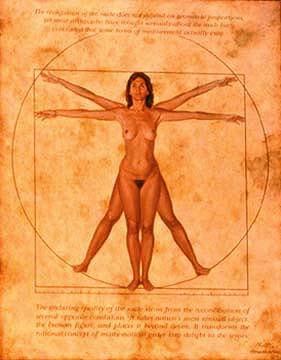
The image in the upper right corner of this page, entitled Vitruvian Woman, is by the award-winning artist, Nat Krate, whose art has been acquired by museums and collectors throughout the United States. The image is used here with the artist's permission. His work can be seen at the Zenith Gallery and his studio in Sarasota, Florida.
Many will recognize her as a modification of the representation of the ideal human by Leonardo DaVinci called Vitruvian Man that is often emblematic of psychology and holistic health, structure, or the arts. For a more thorough review of the history of this image, see The Vitruvian Man website. The title of the work is derived from the name of Marcus Vitruvius, a Roman architect in the first century BCE and author of De Architectura, and is so named because of what are described as its divine mathematical proportions (in Freemasonry, geometry is described as an expression the Great Architect of the Universe). Other representations of Vitruvian Woman that can be found in Google include one by Jay Kalt, another by Mark Weaver, a designer print at CafePress.com, a freeware Windows theme for handheld computers, and an abstract bronze sculpture by Jane DeDecker. Google brings up thousands of masculine variations on DaVinci's theme.
Check out a video rendition of Vitruvian Man on youtube.com.
Relying on the Sacred Geometry of Pythagoras, of which Vitruvius was a proponent, temples were designed based on the proportions of the human body, which was believed to be perfect. This perfection, Vitruvius wrote, was due to the fact that the extended limbs of a perfectly proportioned human fit into both the circle and the square. In other words, as DaVinci observed:
"From the roots of his hair to the bottom of his chin is a tenth of a man's height; from the bottom of the chin to the top of the head is one eighth of his height; from the top of the breast to the roots of the hair will be the seventh part of the whole man." ~ Notebooks of Leonardo
In Pythagorean tradition, the circle represents the spiritual realm; the square, material existence, so the human body represented the perfect marriage of matter and spirit, which was is reflected in its proportions. Squaring is essentially a reference to the human task of giving balance, context, meaning, and understanding to life.
Other representations of Vitruvian Woman that can be found in Google include one by Jay Kalt, another by Mark Weaver, a designer print at CafePress.com, a freeware Windows theme for palm pilots, and an abstract bronze sculpture by Jane DeDecker. Google brings up thousands of masculine variations of DaVinci's concept. See also Squaring the Circle and Leonardos Vitruvian man by Hubert Weller.
On a personal note, I like to think that I have a remote connection to Leonardo. Legend has it that one Marquis DeLaRieux's daughter bore a child to the French monarch, Francis I. If true, this would place king Francis in my direct paternal ancestral line. It's a thinly papered genealogical theory that I enjoy. Moreover, it is said that Leonardo daVinci died in the arms of the king of France. Despite the scant to support this, it does have a grain of truth. The king did protect the artist from a heretic's death and, when the death of Leonardo did in fact occur while he was under the legal protection of the king who was a loving admirer.
